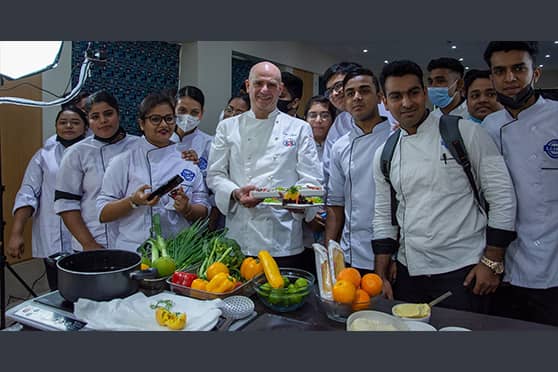IIHM students attend masterclass by Sicilian chef Enzo Oliveri


A masterclass hosted by the International Institute of Hotel Management (IIHM) saw London-based Sicilian chef Enzo Oliveri cook authentic Italian dishes for the third-year culinary students majoring in Food Production.
Oliveri cooked Arancina, an Italian deep-fried rice ball stuffed with vegetables and mozzarella and coated with breadcrumbs; and Fish Carpaccio, a Mediterranean coastal dish of finely sliced fish marinated in lemon.
For both the dishes, Oliveri used easy-to-find kitchen ingredients. “I chose these two dishes because they are from the south of Italy, where I come from. They are simple dishes that can give them the basics to work on. Fish Carpaccio is unique in a way because the marination itself cooks the fish and the rice ball is something that we eat with our hands,” he said. “The cut of the fish has to be very thin and the lines along the pieces should be long enough to absorb the flavour.”
Oliveri also taught the students how to bring out the best in Italian cuisine, shared business and kitchen safety tips and discussed the prospects of Indian hospitality students abroad.
“Indian cuisine is among the most wonderful worldwide. It is inventive, innovative and rich in culture. We train people very hard to get the dishes right. Indian chefs will have a lot of opportunities because they are looked out for all over the world. Indian students already know the basics and with the right amount of training and work on their style, one can have a bright future. Also, the key is to know everything about the kitchen and specialise in something. As a professional, you have to make sure that customers come back to you again. You will have to know what is happening around you and understand your customers so that you can stay afloat,” Oliveri said.
The masterclass ended with an interactive session, where Oliveri told the students how to identify the right brand of pasta in the market based on its colour and the proper temperature and the time taken to cook pizza in an oven. “Eggs give yellow colour to pasta. More eggs mean better quality and ‘coastal’ flavour. Yellower the pasta the healthier it is because of the protein in it. Specialising in pasta can also increase your demand in the market. There are books and information on the internet to make it easy for you,” he added.
Chef Oliveri shared tips like using a high-temperature oven for a shorter time is the secret of a good pizza. “You need to make sure that the outside cooks and the inside stays moist. You don’t want to dry it completely and make it lose its fragrance. You will need 350-400 degrees Celsius for about three minutes to cook a pizza. If you use a fire-burn oven, it will take only 90 seconds,” he added.
Drawing similarities with India, Enzo spoke about how the geographical region and its history shape the ingredients of dishes across Italy. “In the past, people had to make do with what they found locally. If there was water around them, they consumed fish, and if there was land, they consumed meat. Apart from vegetables, these formed the base of used ingredients. The way dishes are cooked varies with the history of conquerors and travellers who have lived in the region. For example, the south was conquered by the Arabs for many years, that’s where we got the imprints of Arabic cuisine. In the north, the dishes like Stroganoff have an Austro-Hungarian and German influence,” he said.
“After two years of going online, I can say that I can transmit my feelings and passion better in the offline format. These classes are essential because these students need to interact more with mentors with experience and expertise,” Oliveri signed off.